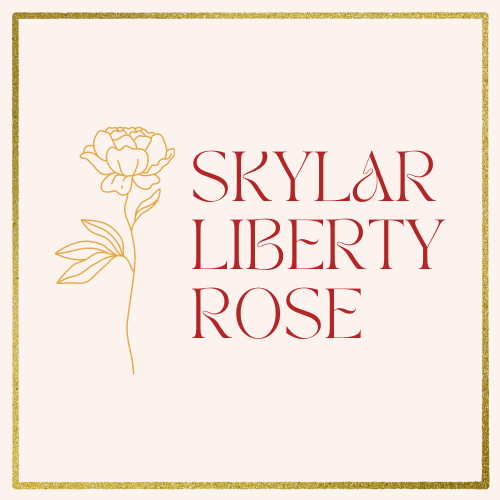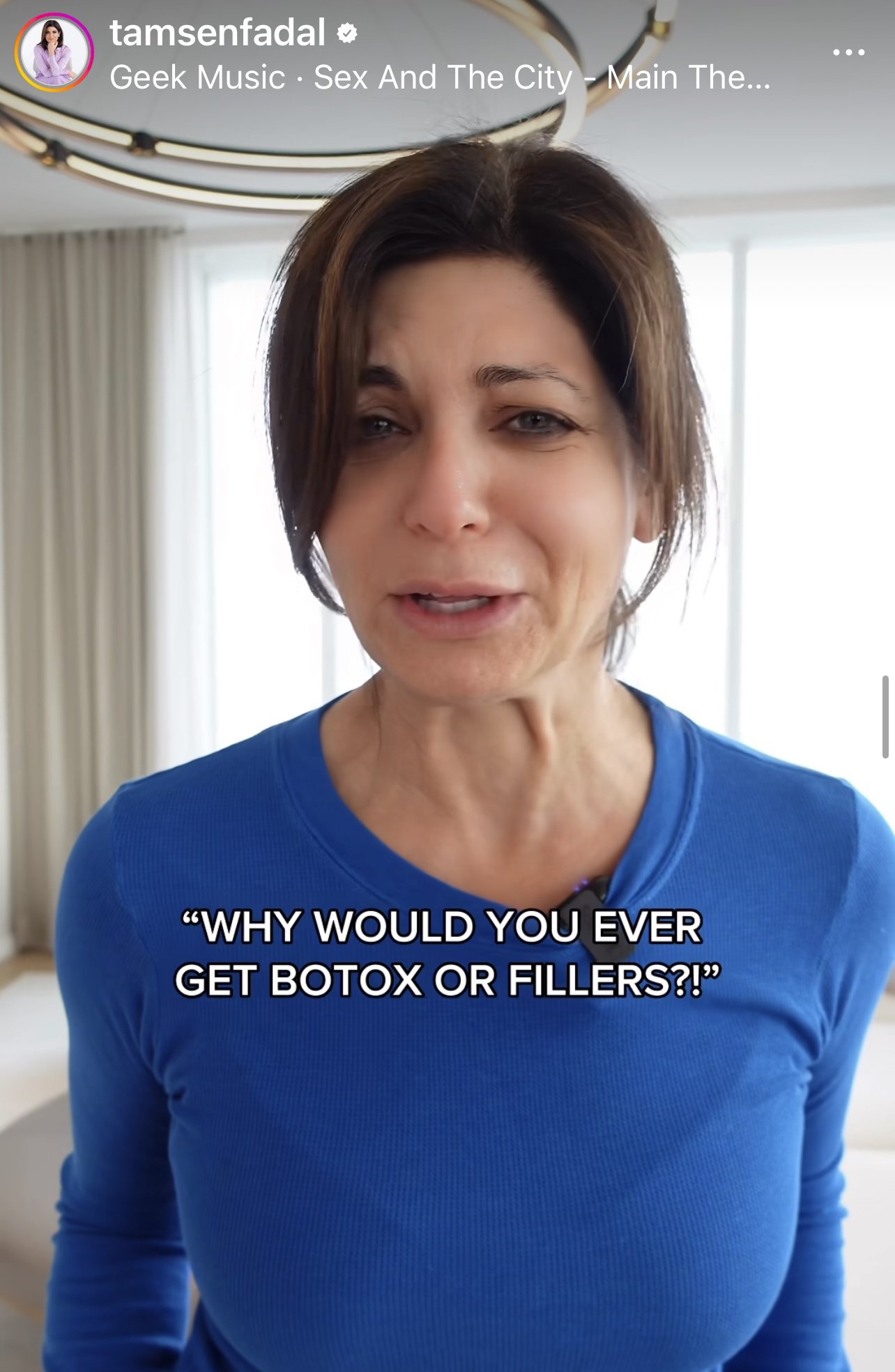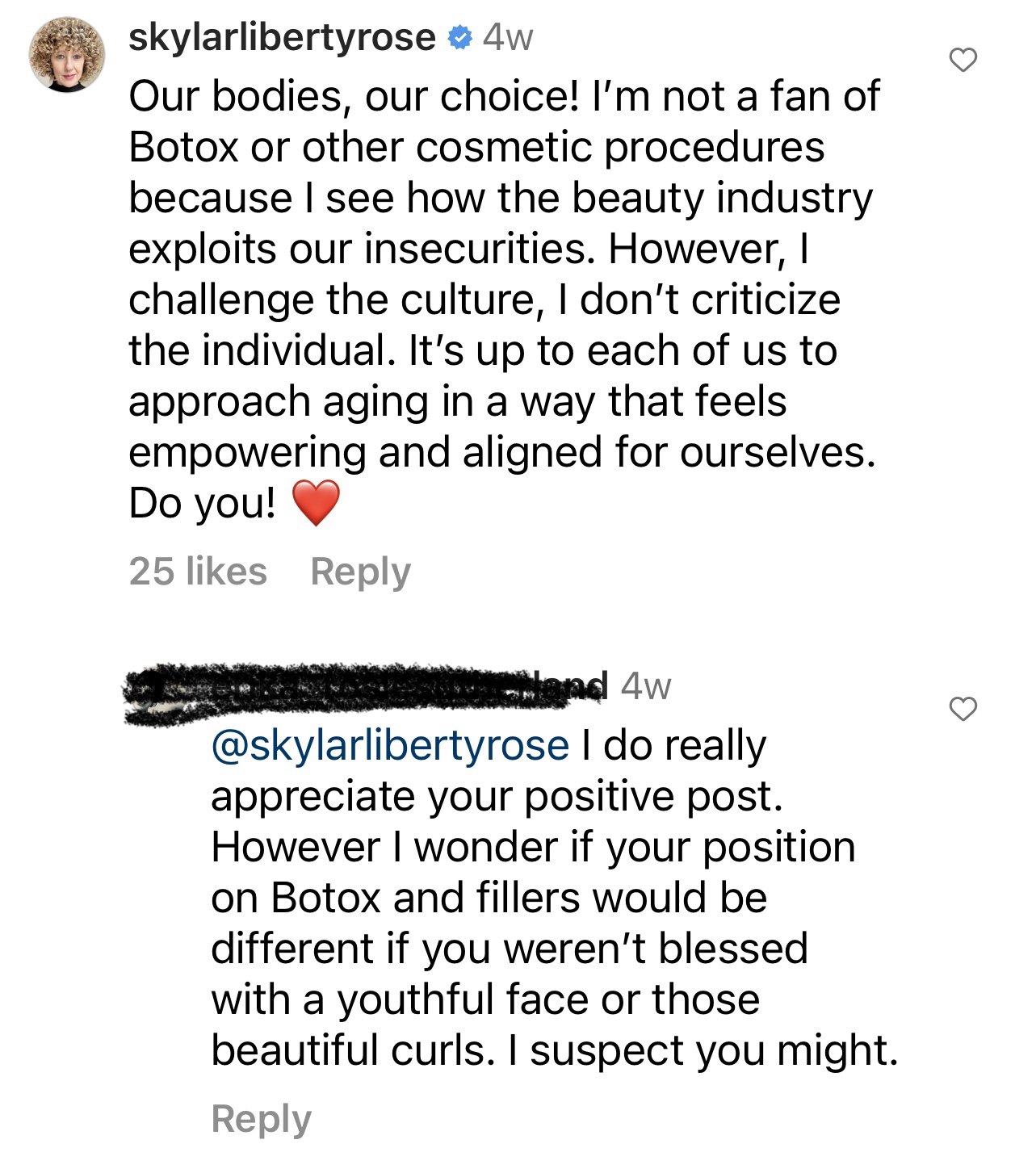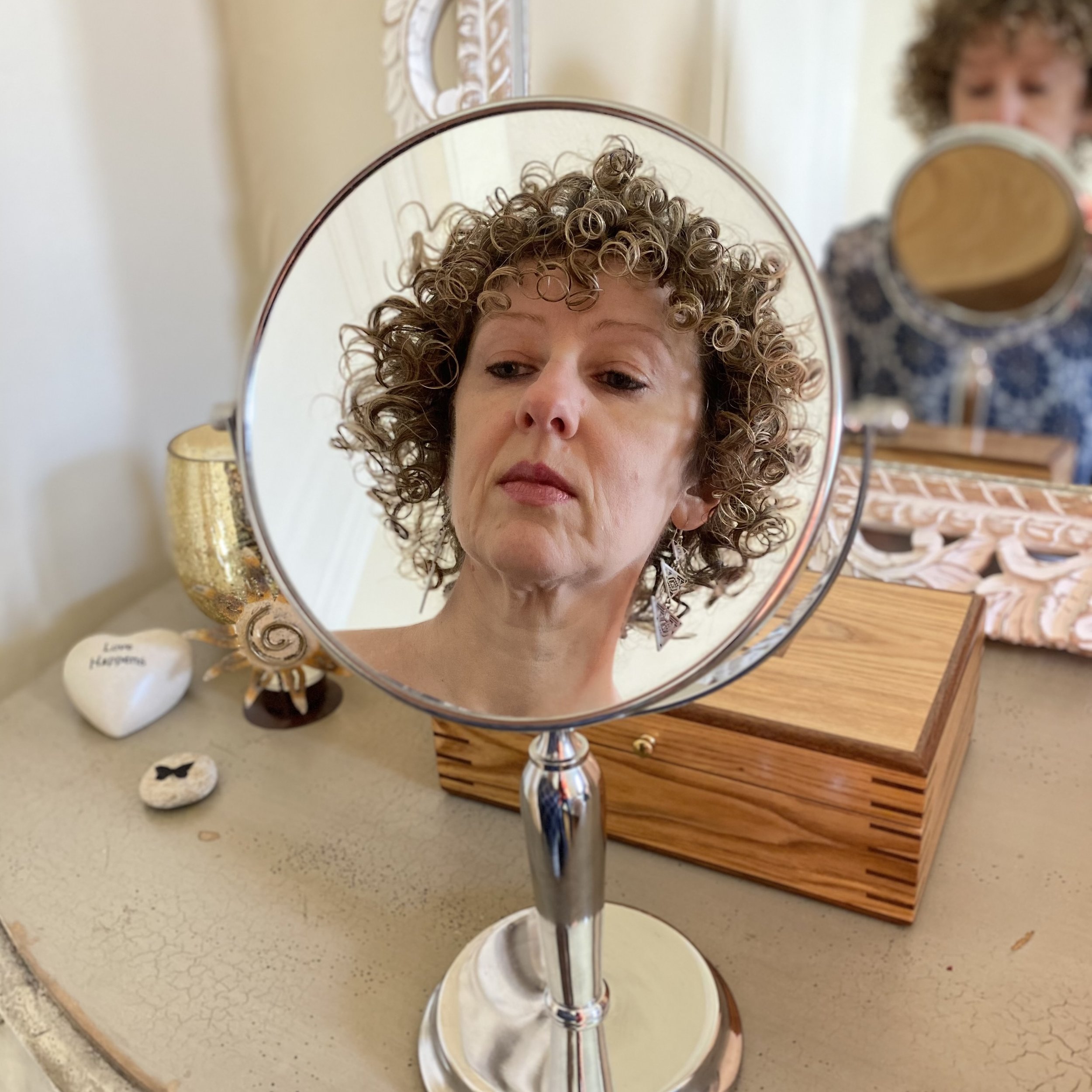How I Really Feel About My Aging Body
Somebody recently commented on Instagram that while my positivity on aging was appreciated, they wondered if my position on Botox and fillers would be different if I wasn’t “blessed with a youthful face or beautiful curls.”
To be clear, this person was replying to a comment I’d left on Tamsen Fadal’s post where she’d spoken about the judgments we place on women who opt for cosmetic procedures. I had commented saying that although I’m not a fan of the way the beauty industry exploits our insecurities, I believe it’s up to each of us to approach aging in a way that feels empowering and aligned for ourselves.
The person who replied to me probably took a quick look at my Instagram profile and made some assumptions about my life based on a few photos. If they’d taken a closer look they would have seen the many photos I’ve shared of my sagging skin and (previously) thinning hair. I’ve made no secret about the fact that my body is changing and I’ve also been honest about how that experience has impacted me.
At 48, I am more confident in who I am and how I look than I ever was at 28. And, it’s also true that I have insecurities and moments of self-doubt.
I was around 44 when I first started noticing the sagging skin under my chin. I’d caught a glimpse of it here and there, but on one particular day I was applying make-up and, to my horror, the angle of my vanity mirror reflected back to me just how much my neck had softened. It was no longer taut or smooth but seemingly losing elasticity by the day.
I was appalled at how old I thought I looked and immediately made a mental note to avoid showing that angle when I was with other people. I couldn’t stand the idea that anyone else might see how slack my skin was.
Around the same time I started to notice that the tops of my thighs had developed a crepe-like texture along with my stomach, breasts and arms. When I looked down at myself I was seeing my grandmother’s skin.
It felt as though it had happened overnight. I’d gone from feeling fairly good about being in my early forties to suddenly having an unwelcome flash of insight that my body and face were changing in a way I wasn’t prepared for. It was a definitive moment. And I didn’t like it one bit.
After sitting with my feelings for a few days, I decided that since I was going to continue aging as long as I was living, I might as well embrace as much of the journey as I could. After all, what was the alternative?
As I began to make my peace with this new chapter, I realized how utterly ludicrous it was that women spend their teens, twenties and thirties being objectified only to reach their forties and fifties and feel as though they’re becoming invisible to society.
I thought of the countless hours and dollars many of us have spent trying to make ourselves as attractive as possible in order to cater to the male gaze only to now spend countless hours and dollars trying to minimize or erase the signs of aging.
We’ve swallowed the lie that our bodies are something to be ashamed of. Too thin, too fat, too curvy, too flat, too dark, too pale… why not add “too old” to the list?
Better still, why not burn the list entirely.
Within a week of me having that vanity mirror moment, I posted photos on social media of the unflattering angles I’d been determined that nobody else should ever see. Instead of hiding my so-called flaws, I chose to highlight them. Because I have learned over and over again that shame cannot survive illumination.
Instead of being terrified that someone might inadvertently see my sagging skin in a photo or video, or in real life, I opted to show the world intentionally. Explicitly. In a way that felt empowering and not shameful at all.
The world wants us to reject our bodies multiple times a day. We’re supposed to slather on fix-it creams and potions. We’re supposed to wear certain clothes and avoid certain colors. We’re supposed to invest our energy trying to detract any attention from the fact that we’re aging. And, of course, buy products to prevent it.
What we’re definitely not supposed to do is put ourselves on display. Because an aging woman who cares far more about unraveling the systems that seek to oppress us, rather than being governed by them, is a dangerous creature indeed. What on earth would the world do with such a woman? How could she possibly be managed?
My own aging awakening prompted me to pivot in my business and focus specifically on helping women feel seen, supported and celebrated as they move through midlife and beyond. It was another definitive moment. Except this time it felt liberating. I felt free to show up fully as myself.
But it’s not a one-and-done thing.
We’ve soaked up decades worth of societal conditioning that has informed our views on what constitutes beauty and who is worthy of being praised. It’s unrealistic to imagine that stepping away from those ideals wouldn’t come with some challenging moments. Although there are more and more of us who are intent on disentangling ourselves from all the expectations that have kept us tucked away in tiny little spaces that feel more stifling than safe, there’s still a billion dollar beauty industry that dispatches disparaging messages to us daily on how unworthy we are. It’s a lot to contend with.
I still have moments where I’m caught off guard and I find myself having inner conflict about the body I have in my mind’s eye, versus the one that’s reflected back to me in reality.
This happened last year when I had emergency surgery for a brain tumor. I thought I was in a good place with how I felt about my body. A place of loving acceptance and gratitude, especially after having survived something that had knocked me for six, physically and emotionally.
But a week or so after the craniotomy, I found myself at home, looking down at my hands thinking “My God, how long was I in the hospital?”
My hands seemed to have aged ten years in two weeks. Even though I knew that it was a superficial thought, and that I was damn lucky to have had a brain tumor and still be alive, I felt as though I was staring at someone else’s hands. Someone much older than me.
I had another difficult moment a couple of weeks ago when I was staying at the Bellagio Hotel in Las Vegas. My husband and I were hoping to squeeze in some pool time before we set off to our next destination. As I looked out of the window at the cabanas in the courtyard, I suddenly struggled to imagine myself sitting out there in my swimsuit. How would my pale cellulite-covered thighs measure up against all the perfect bodies? Wouldn’t I look out of place? Surely people would see me and snicker.
As it turned out, there was no time to enjoy the pool before we had to check out. But, even before I knew that, I’d done a pretty good job of interrupting my self-critical thoughts. I reminded myself of what was true (I have a perfectly good body simply by virtue of the fact that I’m a human being in a body) and what wasn’t true (that everyone else had a “better” body than me) and also what I was projecting (that every single person by the pool possessed body confidence by the bucket load).
I was able to take the shame that had begun to cloak itself around me and stop it in its tracks. Or, at least apply enough logic to realize that it was a figment of fantasy, not rooted in fact.
Our imaginations can be so incredibly potent when it comes to other people’s lives. The woman who replied to me on Instagram made a lot of assumptions about how I feel about my body. I made a lot of assumptions about how the people around the Bellagio pool felt about their bodies. We all do it from time to time. But if we can create some awareness around what’s real and what’s fabricated, we have a better chance of feeling more confident about ourselves, and more compassionate towards others.
I stand by my statement that each of us gets to approach aging in the ways that feel most empowering for us. That doesn’t mean I always feel great about how my body looks or feels. It also doesn’t mean that I’m not committed to calling out the beauty industry for exploiting our vulnerabilities. It simply means I recognize we’re individuals with our own lived experiences who are not all traveling on the same path. How we define a life well-lived will differ. How we decide to resist or embrace aging will differ, too.
To quote Tamsen’s original post “What if we just allowed women to be exactly what they wanted to be without judgment?”
If you’d like to see more posts like this, join me over on Substack. You’ll get all my latest musings emailed to you so you won’t miss a thing.





